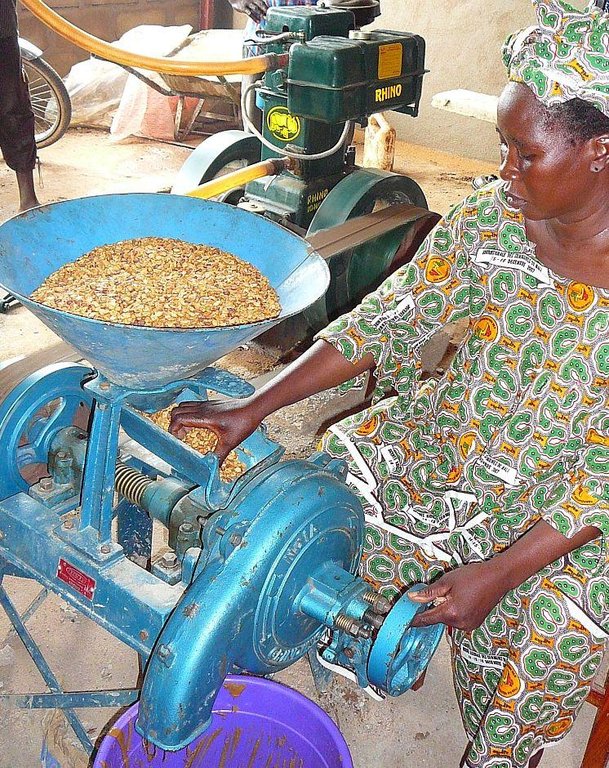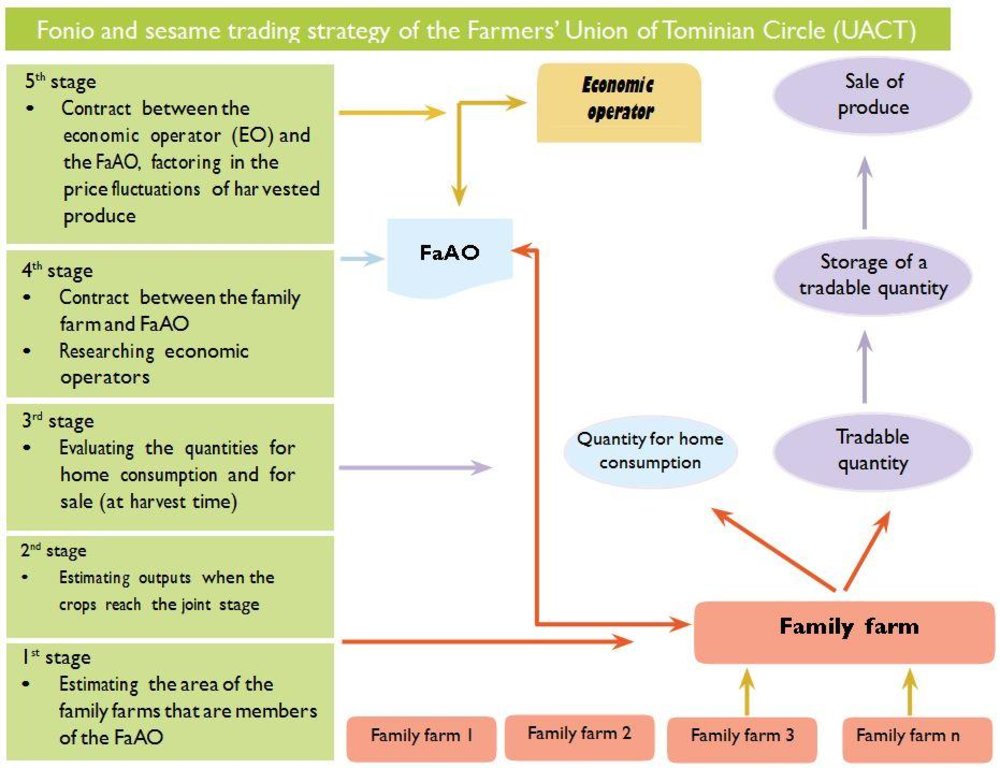Bulk sales approach for farmer apex organisations (FaAO) [มาลี]
- ผู้สร้างสรรค์:
- การอัพเดท:
- ผู้รวบรวม: Dieter Nill
- ผู้เรียบเรียง: –
- ผู้ตรวจสอบ: Laura Ebneter
Approche de commercialisation groupée par des organisations paysannes faitières (OPF))
approaches_2510 - มาลี
ดูส่วนย่อย
ขยายทั้งหมด ย่อทั้งหมด1. ข้อมูลทั่วไป
1.2 รายละเอียดที่ติดต่อได้ของผู้รวบรวมและองค์กรที่เกี่ยวข้องในการประเมินและการจัดเตรียมทำเอกสารของแนวทาง
ผู้เชี่ยวชาญ SLM:
Dacko Maïga Rosaline
rosaline.dacko@helvetas.org
HELVETAS - Swiss Intercooperation
มาลี
ผู้เชี่ยวชาญ SLM:
Keita Lassana
lassana.keita@helvetas.org
HELVETAS - Swiss Intercooperation
มาลี
ผู้เชี่ยวชาญ SLM:
Guindo Idrissa
idrissa.guindo@helvetas.org
HELVETAS - Swiss Intercooperation
มาลี
ชื่อของโครงการซึ่งอำนวยความสะดวกในการทำเอกสารหรือการประเมินแนวทาง (ถ้าเกี่ยวข้อง)
HELVETAS (Swiss Intercooperation)ชื่อของโครงการซึ่งอำนวยความสะดวกในการทำเอกสารหรือการประเมินแนวทาง (ถ้าเกี่ยวข้อง)
Deutsche Gesellschaft für Internationale Zusammenarbeit (GIZ) GmbH (GIZ) - เยอรมนี1.3 เงื่อนไขที่เกี่ยวข้องกับการใช้ข้อมูลที่ได้บันทึกไว้ผ่านทาง WOCAT
วันที่เก็บรวบรวมข้อมูล (ภาคสนาม):
01/07/2012
ผู้รวบรวมและวิทยากรหลักยอมรับเงื่อนไขเกี่ยวกับการใช้ข้อมูลที่ถูกบันทึกผ่านทาง WOCAT:
ใช่
2. คำอธิบายของแนวทาง SLM
2.1 การอธิบายแบบสั้น ๆ ของแนวทาง
Improve the income of family farms by setting up an organized trade mechanism that factors in market price fluctuations.
2.2 การอธิบายอย่างละเอียดของแนวทาง
การอธิบายอย่างละเอียดของแนวทาง:
The objective of the practice is to improve the income of family farms by setting up an organized trade mechanism that factors in market price fluctuations. Structuring trade in this way puts producers in a stronger position in their value chains.
The FaAOs’ approach to trade is based, on the one hand, on purchase agreements for preservable produce (cereals, sesame, etc.) between the FaAO and its producers and, on the other, on sales contracts with one or several market operators/suppliers. The practice enables producers to sell their produce after the harvest at an attractive price, depending on market fluctuations. For the operator, it means a large quantity can be purchased over time, without the need for mobilising major pre-financing resources. As the intermediary, the FaAO benefits from a profit margin and charges levied on transactions.
Stages of implementation: 1) Estimating the areas of family farms that are members of the FaAO: Together with its producers, the FaAO calculates sown areas (of rice, for example) fairly speculatively, providing the first estimates of future outputs. 2) Estimating outputs: Prior to harvesting, the initial estimates made in stage 1 are further refined through crop inspections. 3) Evaluating the quantities for home consumption and for sale: After the harvest, FaAO producers assess what part of their output will be retained for home consumption and what will be sold. 4) Contracting between the family farms and FaAO: The FaAO enters into a contract with the producers for the part to be sold. 5) Contracting between the economic operator and FaAO: Research into economic operators; At a consultation day involving producers, FaAO and operators, a contract is negotiated between FaAO and the operators, who will factor in price increases up to the lean period. Operation: Introducing this approach requires a robust FaAO or family farm, a market analysis and good quality produce. The portion of the output for sale is transferred to the FaAO storage facility. The operator draws down this produce over an extended period. The price for each consignment varies according to the market rate prevailing at the time the produce is drawn down.
Producers provide, process and pack the produce, and enter into a contract with FaAO. The apex organisation researches economic operators, negotiates the sales contract on behalf of the economic operators, stores the produce, monitors sales and manages rebates. Operators draw down produce in line with the terms of the sales contract, and make payments accordingly. Support partners deliver training, provide advisory support and foster contacts.
2.3 รูปภาพของแนวทาง
2.5 ประเทศ ภูมิภาค หรือสถานที่ตั้งที่ได้นำแนวทางไปใช้
ประเทศ:
มาลี
ภูมิภาค/รัฐ/จังหวัด: :
Mali
ข้อมูลเฉพาะเพิ่มเติมของสถานที่ตั้ง:
Ségou, Sikasso
2.6 วันที่เริ่มต้นและสิ้นสุดของแนวทาง
ระบุปีที่เริ่ม:
2008
2.7 ประเภทของแนวทาง
- ใช้โครงงานหรือแผนงานเป็นฐาน
2.8 เป้าหมายหรือวัตถุประสงค์หลักของแนวทาง
The objective of the practice is to improve the income of family farms by setting up an organized trade mechanism that factors in market price fluctuations. Structuring trade in this way puts producers in a stronger position in their value chains.
The SLM Approach addressed the following problems: low income of family farms, market price fluctuations
2.9 เงื่อนไขที่เอื้ออำนวยหรือเป็นอุปสรรคต่อการนำเทคโนโลยีภายใต้แนวทางนี้ไปปฏิบัติใช้
การมีไว้ให้หรือการเข้าถึงแหล่งการเงินและบริการ
- เป็นอุปสรรค
low income of family farms
Treatment through the SLM Approach: setting up an organized trade mechanism that factors in market price fluctuations; purchase agreements for preservable produce (cereals, sesame, etc.) between the FaAO and its producers and sales contracts with one or several market operators/suppliers.
3. การมีส่วนร่วมและบทบาทของผู้มีส่วนได้ส่วนเสียที่เกี่ยวข้อง
3.1 ผู้มีส่วนได้ส่วนเสียที่เกี่ยวข้องในแนวทางนี้และบทบาท
- ผู้ใช้ที่ดินระดับท้องถิ่นหรือชุมชนระดับท้องถิ่น
- ผู้เชี่ยวชาญ SLM หรือที่ปรึกษาการเกษตร
- องค์กรพัฒนาเอกชน
- รัฐบาลระดับท้องถิ่น
- รัฐบาลแห่งชาติ (ผู้วางแผน ผู้ทำการตัดสินใจ)
3.2 การเกี่ยวข้องของผู้ใช้ที่ดินระดับท้องถิ่นหรือชุมชนระดับท้องถิ่นในช่วงต่างๆของแนวทาง
| ความเกี่ยวข้องของผู้ใช้ที่ดินระดับท้องถิ่นหรือชุมชนระดับท้องถิ่น | ระบุผู้ที่มีส่วนเกี่ยวข้องและอธิบายกิจกรรม | |
|---|---|---|
| การริเริ่มหรือการจูงใจ | ไม่ลงมือ | |
| การวางแผน | ปฏิสัมพันธ์ | |
| การดำเนินการ | ปฏิสัมพันธ์ | |
| การติดตามตรวจสอบหรือการประเมินผล | ปฏิสัมพันธ์ | |
| Research | ไม่ลงมือ |
3.3 แผนผังแสดงขั้นตอนการทำงาน (ถ้ามี)
3.4 การตัดสินใจเลือกใช้เทคโนโลยี SLM
ระบุผู้ที่ทำการตัดสินใจเลือกเทคโนโลยีมากกว่าหนึ่งวิธีไปปฏิบัติใช้:
- ผู้เชี่ยวชาญ SLM เป็นผู้ตัดสินใจหลัก ที่ติดตามให้คำปรึกษากับผู้ใช้ที่ดิน
การอธิบาย:
Decisions on the method of implementing the SLM Technology were made by mainly by SLM specialists with consultation of land users
4. การสนับสนุนด้านเทคนิค การสร้างขีดความสามารถ และการจัดการด้านความรู้
4.1 การสร้างขีดความสามารถ / การอบรม
ได้มีการจัดอบรมให้แก่ผู้ใช้ที่ดินหรือผู้มีส่วนได้ส่วนเสียคนอื่น ๆ หรือไม่:
ใช่
ให้ระบุว่าใครเป็นผู้ได้รับการอบรม:
- ผู้ใช้ที่ดิน
รูปแบบการอบรม:
- กำลังดำเนินการ
- เกษตรกรกับเกษตรกร
- จัดการประชุมสู่สาธารณชน
หัวข้อที่พูด:
Support partners deliver training, provide advisory support and foster contacts.
4.3 การเสริมความแข็งแกร่งให้กับสถาบัน (การพัฒนาองค์กร)
สถาบันได้รับการจัดตั้งขึ้นมาหรือเสริมความแข็งแกร่งโดยแนวทางนี้หรือไม่:
- ใช่ อย่างมาก
ระบุระดับของสถาบันที่ได้รับการเสริมความแข็งแกร่งหรือจัดตั้งขึ้นมา:
- ท้องถิ่น
ระบุประเภทของการให้ความช่วยเหลือสนับสนุน:
- ด้านการเงิน
ให้รายละเอียดเพิ่มเติม :
Improve the income of family farms by setting up an organized trade mechanism that factors in market price fluctuations. Structuring trade in this way puts producers in a stronger position in their value chains.
4.4 การติดตามตรวจสอบและประเมินผล
การติดตามตรวจสอบและประเมินผลเป็นส่วนหนึ่งของแนวทางหรือไม่:
ใช่
ความคิดเห็น:
socio-cultural aspects were ad hoc monitored by project staff, land users through observations
economic / production aspects were regular monitored by project staff through measurements
management of Approach aspects were ad hoc monitored by project staff through observations
There were no changes in the Approach as a result of monitoring and evaluation
There were no changes in the Technology as a result of monitoring and evaluation
4.5 การวิจัย
การวิจัยเป็นส่วนหนึ่งของแนวทางหรือไม่:
ใช่
ระบุหัวข้อเรื่อง:
- สังคมวิทยา
- เศรษฐศาสตร์หรือการตลาด
5. การสนับสนุนด้านการเงินและวัสดุอุปกรณ์
5.1 ระบุงบประมาณประจำปีสำหรับแนวทาง SLM นี้
แสดงความคิดเห็น (แหล่งของการระดมทุน ผู้บริจาคคนสำคัญ):
Approach costs were met by the following donors: international non-government: 100.0%
5.2 การสนับสนุนด้านการเงิน / วัสดุอุปกรณ์ให้แก่ผู้ใช้ที่ดิน
ผู้ใช้ที่ดินได้รับการสนับสนุนด้านการเงิน / วัสดุอุปกรณ์ไปปฏิบัติใช้เทคโนโลยีหรือไม่:
ไม่ใช่
5.4 เครดิต
มีการจัดหาเครดิตมาให้ภายใต้แนวทาง SLM หรือไม่:
ไม่ใช่
6. การวิเคราะห์ผลกระทบและการสรุป
6.1 ผลกระทบของแนวทาง
ช่วยให้ผู้ใช้ที่ดินนำเอาเทคโนโลยี SLMไปใช้และบำรุงรักษาสภาพไว้ได้หรือไม่:
- ไม่ใช่
- ใช่ เล็กน้อย
- ใช่ ปานกลาง
- ใช่ อย่างมาก
The approach offers producers greater opportunities to access enhanced seeds and inputs (credibility among service providers).
ทำให้กลุ่มด้อยโอกาสมีอำนาจทางสังคมและเศรษฐกิจหรือไม่:
- ไม่ใช่
- ใช่ เล็กน้อย
- ใช่ ปานกลาง
- ใช่ อย่างมาก
When prices become more lucrative, producers are less inclined to sell off their harvest; the risk of slumps in prices is minimal.
Did other land users / projects adopt the Approach?
- ไม่ใช่
- ใช่ เล็กน้อย
- ใช่ ปานกลาง
- ใช่ อย่างมาก
Implementation locations: Ségou and Sikasso. 12,750 beneficiaries are applying this approach in 14 apex organisations.
Did the Approach lead to improved livelihoods / human well-being?
- ไม่ใช่
- ใช่ เล็กน้อย
- ใช่ ปานกลาง
- ใช่ อย่างมาก
Puts producers in a stronger position in their value chains. Incomes are stabilised, which improves living conditions and social cohesion. Communities are better able to pay taxes and more receptive to formalised contracts.
Did the Approach help to alleviate poverty?
- ไม่ใช่
- ใช่ เล็กน้อย
- ใช่ ปานกลาง
- ใช่ อย่างมาก
6.2 แรงจูงใจหลักของผู้ใช้ที่ดินเพื่อที่จะนำ SLM ไปปฏิบัติใช้
- การผลิตที่เพิ่มขึ้น
- กำไร (ความสามารถ) อัตราส่วนค่าใช้จ่ายต่อผลประโยชน์ที่เพิ่มขึ้น
6.3 ความยั่งยืนของกิจกรรมของแนวทาง
ผู้ใช้ที่ดินสามารถทำให้สิ่งต่างๆ ที่ได้ปฏิบัติใช้โดยแนวทางนี้ยั่งยืนได้หรือไม่ (โดยไม่มีการสนับสนุนจากภายนอก):
- ไม่แน่ใจ
6.4 จุดแข็งและข้อได้เปรียบของแนวทาง
| จุดแข็ง / ข้อได้เปรียบของแนวทางในทัศนคติของผู้รวบรวมหรือวิทยากรหลัก |
|---|
| Bank loans guaranteed as a result of retained stocks and management tools |
|
Guaranteed revenues for small-scale producers |
| Improved post-harvest management |
| As revenues grow, producers seek to maximise their cropping schedules in order to earn more money. The approach offers producers greater opportunities to access enhanced seeds and inputs (credibility among service providers). When prices become more lucrative, producers are less inclined to sell off their harvest; the risk of slumps in prices is minimal. Incomes are stabilised, which improves living conditions and social cohesion. Communities are better able to pay taxes and more receptive to formalised contracts. |
| Price stabilisation (to prevent produce from being sold-off) and improved producer incomes (How to sustain/ enhance this strength: A thorough market analysis must be conducted to enable market price fluctuations to be accurately predicted and the best times for sale to be pinpointed. Client relationships must be professional and contractual. Informal commitments often fall through. The FaAO must have committed and business-minded leaders. It is wise to stay vigilant when it comes to the governance of these organisations, as they can fall prey to corrupt practices and the embezzlement of collective funds.) |
7. การอ้างอิงและการเชื่อมต่อ
7.1 วิธีการหรือแหล่งข้อมูล
- ไปเยี่ยมชมภาคสนาม การสำรวจพื้นที่ภาคสนาม
- การสัมภาษณ์กับผู้ใช้ที่ดิน
7.2 การอ้างอิงถึงสิ่งตีพิมพ์
ชื่อเรื่อง ผู้เขียน ปี ISBN:
Manual of Good Practices in Small Scale Irrigation in the Sahel. Experiences from Mali. Published by GIZ in 2014.
ช่องทางในการสืบค้น และราคา:
http://star-www.giz.de/starweb/giz/pub/servlet.starweb
ชื่อเรื่อง ผู้เขียน ปี ISBN:
HELVETAS Swiss Intercooperation: annual report 2010-2011 for the San Hub (Pôle de San)
ชื่อเรื่อง ผู้เขียน ปี ISBN:
HELVETAS Swiss Intercooperation (2013): JIGIYA programme evaluation report
ลิงก์และโมดูล
ขยายทั้งหมด ย่อทั้งหมดลิงก์
ไม่มีลิงก์
โมดูล
ไม่มีโมดูล





